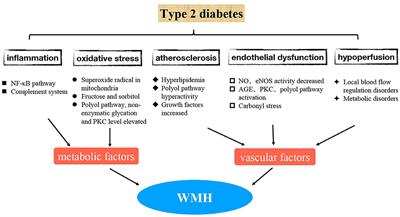
The continually increasing number of patients with type 2 diabetes is a worldwide health problem, and the incidence of microvascular complications is closely related to type 2 diabetes. Structural brain abnormalities are considered an important pathway through which type 2 diabetes causes brain diseases. In fact, there is considerable evidence that type 2 diabetes is associated with an increased risk of structural brain abnormalities such as lacunar infarcts (LIs), white matter hyperintensities (WMHs), and b rain atrophy. WMHs are a common cerebral small-vessel disease in elderly adults, and it is characterized histologically by demyelination, loss of oligodendrocytes, and vacuolization as a result of small-vessel ischemia in the white matter. An increasing number of studies have found that diabetes is closely related to WMHs. However, the exact mechanism by which type 2 diabetes causes WMHs is not fully understood. This article reviews the mechanisms of type 2 diabetes-related WMHs to better understand the disease and provide help for better clinical treatment.



No comments:
Post a Comment